What’s Up
On our last morning at DeSoto there were some egrets in the washover pond, but with few baitfish, there was very little action. Working on the Panning Ground Pod with the 600 f/4GM lens, I went after some more eye-level Marbled Godwit images using the rear monitor. After a bit, I added the 1.4X TC. Several really sweet Dunlins made their way into the shallow pool I was working. I did well. My problem the previous day was that the Dunlin never stopped their rapid, sewing-machine-like feeding. After about ten minutes, four Dunlin, lit by soft early sunlight, decided to stop and stand right in front of me and right down sun angle to rest and preen. I made a lot of images. Really fine images.
At times I sat with the lens at ground level and worked off the monitor. At times I got down flat on the muck and worked through the viewfinder. And at times I lay on the sandy mud and worked off the monitor. The advantage of the latter is that it is much easier for me to see what is going on without my glasses as I am only a few inches from the monitor. When I am sitting and using the rear monitor my left eye is about 20 inches from the monitor; without my glasses, I am often guessing as to the AF performance and the orientation and head angle of the subject.
Next I decided to try to get close to the Red Knot flock on a different flat that abutted the lagoon. They were much tamer than they had been the day before. I got on the ground easily at about fifty yards and advanced slowly mostly by rolling. Yes, rolling. No matter how I advanced, both shoulders were hurting. After about an hour, I had moved about 40 yards and gotten within about ten yards of the birds — easy pickings at 1200mm on a then-cloudy/very bright morning. But the flock was tightly packed; isolating a single bird was close to impossible. I did get one pretty nice bird sleeping and was able to isolate a single preening Dublin, but that was about it.
Today is Thursday 13 May. The forecast for this morning at ILE is for partly cloudy turning cloudy with a northeast wind … I have not decided whether or not to head down to the lake as I need to get some work done for the Sony Alpha a1 Info and Updates group. Wherever you are, and whatever you are doing, I hope that you have a great day.
This blog post took more than 2 hours to prepare and makes 140 straight days with a new one. Please remember that if an item — a Delkin flash card, or a tripod head, for example, that is available from B&H and/or Bedfords and is also available in the BAA Online Store, it would be great if you opt to purchase from us. We will match any price. Please remember also to use my B&H affiliate links or to save 3% at Bedfords by using the BIRDSASART discount code at checkout. Doing either often earns you free guides and/or discounts. And always earns my great appreciation.
|
|
|
Notice the under-side of the right sleeve of my sun protective blouse. You can tell that I had been doing lots of crawling on my belly in the muck. artie after Gulf bath. Image courtesy of and copyright 2021: Anita North |
Cleaning Up at the Beach
It seemed as if I had been photographing for many hours; I thought that it was after eleven. So I headed back to the car, wet and covered in sand from head to toe. I was shocked to see that it was only 9:30am. Anita had headed off early to the far north end of Outback Key. I thought that she might already be back to the car. She was not. I called her cell and got her. She was headed back, but was still about 15 minutes away. I asked her to meet me at the Gulf beach in front of the parking lot and she did. Then, with all of my clothes on, I went for a delightful swim to get cleaned up a bit, albeit in saltwater. At my request, she created a few before snaps of me (dirty and sandy), and a few after snaps (cleaner and wetter), with her 200-600.
Now I was ready for a grand shower in the men’s room bathhouse at North Beach. Several years back, they redid the showers, but removed the bench and the clothes hooks. I was puzzled as to why. So anyhoo, I walk in, go around the new partition, and much to my surprise, I see a lovely, wide wooden bench. Could it get any better? So I put my complete change of clothes on the bench along with a brand new can of Johnson’s baby powder, my sandals, my robe, and a clean towel. I get out of my wet, sandy clothes and turn around. There I see eight very clean shower stalls. With all of the plumbing removed. As Anita would say, “Rotter!”
So I put my wet, sandy clothes back on and headed to the multi-level outdoor sprinkler/shower nearby. I took a nice shower, eventually stripping down to just my green Jockey shorts. Yikes! (No pictures of that, thank the lord.) I quickly put on my robe, made my way back to the bench, powdered my feet, and got dressed.
On the way back to ILE we stopped at Bass Pro Shops in Brandon for a bit of shopping, at Starbucks in Bartow (so Anita could get another fix), and at Publix in Lake Wales to pick up something for dinner. We got back to ILE at about 3:30pm. It was just another exciting day in the life of a professional bird photographer.
Scanning Help Needed
If you know anything about scanning slides, please leave a comment below or contact Jeff Walters via e-mail.
Jeff Walters/May 12, 2021 at 4:42 pm
Great skimmer shots and mating avocets images show truly why I love bird photography. Thanks to your friends for sharing their images and thank-you for bringing them to us in your blog.
If you had a mess of old slides, how would you go about digitizing them today, sir? And could it be done for a reasonable cost? I ask, because seeing the skimmer image reminds me of shots I have on slide film from years past. I have many terrific skimmers shots, and image of many other species from wetlands on slide film. I would love to find an affordable way to get them converted to digital. Anyone’s comments or assistance would be most appreciated and especially any guidance from you Artie! Thanks to all.
Arthur Morris/BIRDS AS ART/May 12, 2021 at 7:27 pm
Hi Jeff,
Scanning slides is not my area of expertise … Lots of folks (including me), used something like a Nikon Cool Scan. Or tried to. Most of the time, it did not work at all. When it did, the results were not very good. Getting a drum scan is best but they are expensive. I will run this in the blog and see if anyone can help. Don’t forget that compared to digital, film sucks. Period. So it stands to reason that by scanning something that sucks to being with, you will wind up with something that sucks … If you follow my drift.
with love, artie
ps: if you do want to have some slides scanned, I would limit that to your very strongest images …
Bedfords
The very affable Steve Elkins asked me to let you know that Bedfords has many Canon R5 bodies in stock right now. He is expecting some Control Ring Adapters, more than a few Canon RF 70-200s, and several RF 800mm lens in a day or two. Don’t forget to save 3% at Bedfords (and enjoy free 2nd-Day Air fed-Ex) by using the BIRDSASART discount code at checkout.
Please Remember
With income from IPTs greatly reduced, please — if you learn from and enjoy the blog, remember to use one of my two affiliate programs when purchasing new gear. Doing so just might make it possible for me to avoid having to try to get a job as a Walmart greeter and will not cost you a single penny more. And if you use Bedfords and remember to enter the BIRDSASART code at checkout, you will save 3% on every order and enjoy free second-day air shipping. In these crazy times — I am out at least forty to sixty thousand dollars so far due to COVID 19 (with lots more to come) — remembering to use my B&H link or to shop at Bedfords will help me out a ton and be greatly appreciated. Overseas folks who cannot order from the US because of import fees, duties, and taxes, are invited to help out by clicking here to leave a blog thank you gift if they see fit.
New and Better Bedfords Discount Policy!
You can now save 3% on all of your Bedfords photo gear purchases by entering the BIRDSASART coupon code at checkout. Your discount will be applied to your pre-tax total. In addition, by using the code you will get 2nd day air shipping via Fed Ex.
Grab a Nikon AF-S Teleconverter TC-14E III and save $14.99. Purchase a Canon EOS R5 and your discount will be $116.97. Purchase a Sony FE 600mm f/4 GM OSS lens and save a remarkable $389.94! Your Bedford’s purchase no longer needs to be greater than $1,000.00 for you to receive a discount. The more you spend, the more you save.
Money Saving Reminder
Many have learned that if you need a hot photo item that is out of stock at B&H and would enjoy free second-day air shipping, your best bet is to click here, place an order with Bedfords, and enter the coupon code BIRDSASART at checkout. If an item is out of stock, contact Steve Elkins via e-mail or on his cell phone at (479) 381-2592 (Central time). Be sure to mention the BIRDSASART coupon code and use it for your online order to save 3% and enjoy free 2nd-day air shipping. Steve has been great at getting folks the hot items that are out of stock at B&H and everywhere else. The wait lists at the big stores can be a year or longer for the hard to get items. Steve will surely get you your gear long before that. For the past year, he has been helping BAA Blog folks get their hands on items like the SONY a9 ii, the SONY 200-600 G OSS lens, the Canon EOS R5, the Canon RF 100-500mm lens, and the Nikon 500mm PF. Steve is personable, helpful, and eager to please.


Gear Questions and Advice
Too many folks attending BAA IPTs (remember those?) and dozens of photographers whom I see in the field and on BPN, are–out of ignorance–using the wrong gear especially when it comes to tripods and more especially, tripod heads… Please know that I am always glad to answer your gear questions via e-mail.
|
|
Georgina Steytler
In the Australian Lady Bird Photographer Georgina Steytler Creates High-Key, Soft Light, and Dramatic Stunners … blog post here, all were invited to leave a comment listing no more than three of their favorite images created by the quite amazing Georgina Steytler and to let us know why they made their choice or choices.
Lots of folks commented on the superb artistry of the collection, but only a few were specific. Including my favorites, Image #7: New Holland Honeyeaters, was the leader with three mentions. The Red-capped Parrot on Bottlebrush, #3, the Pacific Black Duck, #5, and the Great Egret abstract, #9, all garnered three mentions. The Pacific-Gull flapping, #4, and Red-capped Plover on the run, each were mentioned once.
Though there is — of course — no rights or wrongs when judging the artistic merits of photographs, Phill Bird echoed my feelings when he wrote:
Thanks for introducing us to Georgina’s work, Artie. Lots of fantastic images and the standout for me is the Red-capped Parrot. The parrot’s beautiful coloring standing out in the misty lighting and the inclusion of the quintessentially Australian Bottlebrush in the composition appeals greatly to me.
As always, remember that looking at (and evaluating) great imagery is one of the very best ways to improve your own photography … You can see my three favorites by scrolling down.
|
|
Image #3: Red-capped Parrot on Bottlebrush. Image courtesy of and copyright 2018: Georgina Steytler |
My Very Favorite Georgina Steytler Image
I fell in love with this one the moment I saw it as I am a sucker for a good watercolor. The bird is sharp and perfectly positioned in the frame. And the pastel colors are incredible. The erect pose is perfect as is the selective focus on the subject. Your eye is led around the frame from the REDs on the bird to the REDs in the flower and also by the sharp to soft transitions.
|
|
Image #5: Pacific Black Duck preening. Image courtesy of and copyright 2018: Georgina Steytler |
My First Tied-for-Second Favorite Georgina Steytler Image
With the vibrant colors of the duck’s speculum and the striking black background, this is another spectacular image. I am, however, betting that Georgina wished she had pointed her lens down just a bit so as to include more of (if not the complete) reflection … Do notice that this one works very well despite the fact that we see neither the bird’s eyes nor its face. You are the artist; you get to break the rules with purpose.
|
|
Image #7: New Holland Honeyeaters. Image courtesy of and copyright 2018: Georgina Steytler |
My Second Tied-for-Second Favorite Georgina Steytler Image
Note: this section of the blog was inadvertently deleted but I am not sure when that happened. I am restoring it just after noon on 14 May.
Here we have another watercolor-like photo with tons of action and interaction. That five of the seven honeyeaters are not only facing the camera but have excellent head angles is quite amazing. And the squabbling pair at the top is the proverbial icing on the cake.
Typos
With all blog posts, feel free to e-mail or to leave a comment regarding any typos or errors.

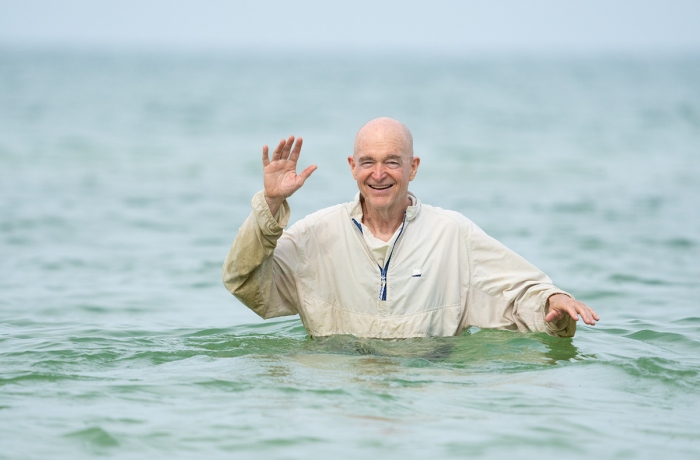

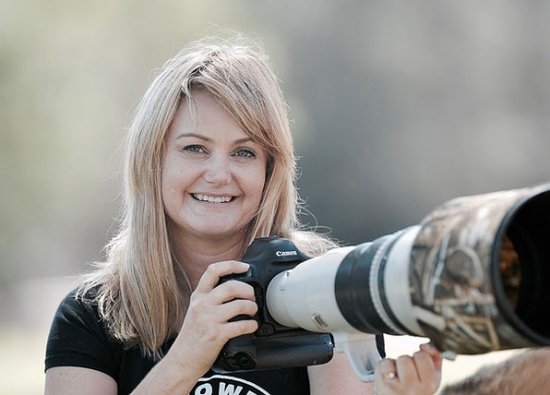
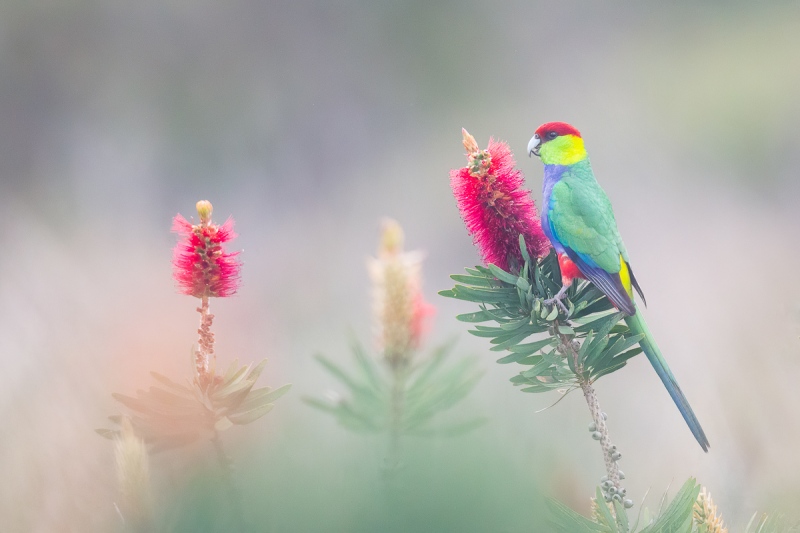
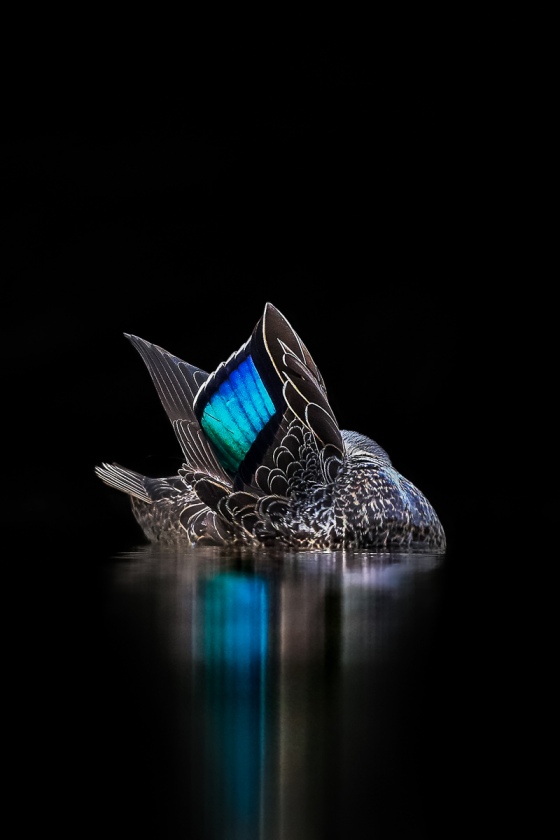
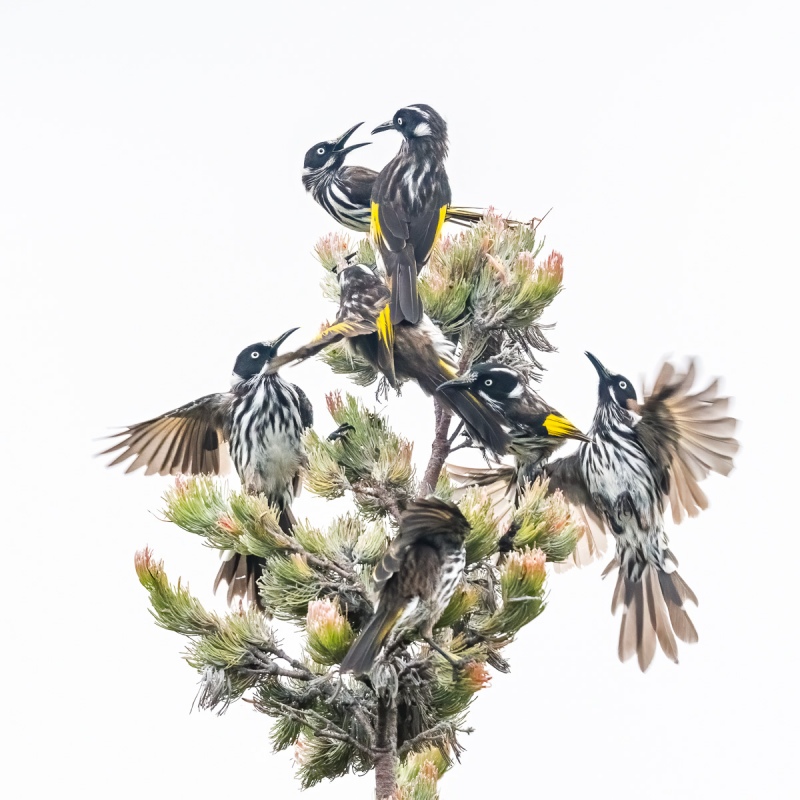













Hi Jeff: SilverFast has just released an upgraded version 9. A quick look on the website (https://www.silverfast.com/silverfast9/) shows that they offer three versions; SE, SE Plus, and Ai Studio. I recall that in the past some scanners came with an SE version, which is the scaled down version. SE Plus adds on some additional features, and Ai Studio is the high end version with all the bells and whistles. I use the Ai Studio version for 2 scanners ( Nikon Super Coolscan 5000 ED and the Epson V800) which requires the purchase of 2 copies, one for each scanner as the drivers are different. The Ai version also offers an add-on for HDR at a bit higher price. It’s not cheap, but if it offers what is needed for scanning (as far as quality quality and versatility) it’s worth it in the long run to me, especially compared to sending slides out for digitizing. Check out the different versions at the link above. I believe you can also try demo versions of the software before you buy. Also, I recall reading somewhere in the past that George Lepp was using the light panel method to digitize many, if not most, of his older slides (check Outdoor Photographer back issues, or email him). Using the 100mm Macro lens will give you a full size digital copy when shot at 1X.
Jeff: I have a Nikon Super Coolscan 5000 ED that scans slide and roll film (35mm). These are no longer made but are available on the secondhand market. It does a great job with a native resolution of 4000 ppi. The original driver will probably not work well, if at all, with Windows 10. What I use for a driver is LaserSoft Imaging’s SilverFast Ai for the Nikon Super Coolscan. (Their drivers and software are device specific, I use 2 versions, one for the film scanner and the other for a flatbed scanner.) This software does a great job and is very versatile. You could probably also find the slide feeder SF210 for the 5000 ED that holds up to 50 mounted slides for quicker processing. To get a good handle on how to get the image into the computer I recommend the book “Digital Restoration From Start to Finish” by Ctein (available on Amazon), now in its 3rd edition. One entire chapter is devoted to digitizing images into the computer. I am using the book as a reference guide in digitizing tons of old family photographs (dating back to the 1860s) and negatives (dating back to the 1920s). Needless to say those who captured the images did not have the benefit of RawDigger as exposures are all over the place.
An alternative approach would be to find and use a copy stand (available at B&H Photo-Video). This is built to have the base (where the to be copied item goes) and the film plane/digital sensor parallel. Place an Artograph Light Panel on the base, then place the mounted slide on light panel, and then place on the top a sheet of black art paper or board with a cutout in the middle for the film portion of the slide to eliminate light flare. Use a macro lens to focus on the slide and go from there. This approach will likely be significantly less costly than the Nikon Super Coolscan 5000 ED approach.
Good Luck!
Thanks Dane – I really appreciate any and all suggestions. Is the SilverFast AI the one that comes with some slide scanners or is that the high end upgrade?
Image #1 is nice, but the bird seems to have lost some of its plumage. Perhaps it is molting?
On my last birthday Anita caught me asleep on the couch and shaved my head!
with love, a
Where’s the fine feather detail on the “artie after gulf bath”? 😉
It got washed away! That water felt great.
with love, artie
Here’s a link to Nikon’s ES-1 page:
https://www.nikonusa.com/en/Nikon-Products/Product/Slide-Copy-Adapters/ES-1-Slide-Copying-Adapter-for-52mm-Thread.html
Thanks for the info. I have a Canon 7D MkII.
I believe you can still use the ES-1 — it’s not Nikon-specific. The 7D is a crop-sensor body, so you’ll need less than 1:1 magnification. See the 5/14/21 blog post for a comment by someone who uses the ES-1 on a Canon.
These Ft D posts are making my shutter finger twitch. Tell Steve his R5 stock is great, but he needs one more a1.
P.S. Want to thank Artie and Steve Schiff for yesterday’s discussion of sentence construction and Sony’s takeover of the solar system. Wonderfully funny.
On scanning, I’m still using a Nikon Coolscan (discontinued by Nikon more than a decade ago). Mine requires a Firewire card added to my computer, but the later ones I think were USB. Also takes a 10-step workaround to get Windows 8 or 10 to accept it. It’s slow, but can give very good results, especially with large-in-the-frame images. In good condition, these go for more now than they did new (roughly $1,000 then). Combining a dark and a light scan helps, and Topaz DeNoise helps a lot. I once had 30+ drum scans done by a guy who’d scanned for Galen Rowell, and while file sizes are larger, I don’t find the drum scans superior to the Nikons.
The other Art (Wolfe) has an assistant using an even more expensive and capable Imacon scanner (also long discontinued), also with DeNoise. Wolfe says scans of good slides from the 1970s look like they were made yesterday (though still not equal to digital, of course). But for many uses–books, engagement calendars, slideshows, etc.–you can’t tell the difference. And of course many photos of landscapes and native peoples made decades ago couldn’t be made today.
I tried using a 100mm macro lens and an expensive ($1,500) illuminated slide stage maybe 18 months ago, thinking the greater resolution and dynamic range of digital would produce quicker, better results. But it wasn’t quick, because it was almost impossible to get the flimsy stage square to the camera (it adjusted, idiotically, with a set screw at each of the four corners), and the results didn’t even come close to the Nikon scans. I have seen good results reported using an inexpensive Nikon slide holder (the ES-2) designed to attach to a specific Nikon macro lens (or lenses). If you have a Nikon body, that would seem a good choice, definitely worth a try.
The Nikon slide holder does not require a Nikon lens. Any closeup lens will do, maybe with a stepup or stepdown ring adapter.
Thanks. I own a Canon 7D Mk II. I really appreciate all the suggestions and tips.
I use a Nikon ES-1 Slide Copy Adapter ($59 bucks) scan adapter with a closeup lens of any brand
Mike